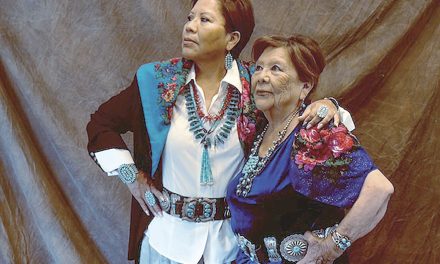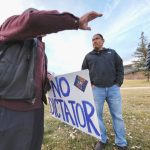
Taxes arise as barrier to solar power development
WINDOW ROCK
One of the challenges holding back proposed renewable solar projects on the Navajo Nation is taxation and the issue was discussed on Monday among solar companies and the Resources and Development Committee.
The presenters that spoke to the committee were representatives of Navajo Transitional Energy Company, Photosol US, Navajo Power and Uniper Energy.
Clara Pratt, founder and partner of Navajo Power, said so much solar is happening within the neighboring communities because in those jurisdictions there are a lot of exemptions on tax or abatements.
These jurisdictions do this by providing tax exemptions for the purchase of solar equipment and/or they have property tax abatement programs and gross receipt tax exemptions, she said.
Pratt said this causes developers to look at the costs and make decisions on whether solar is developed in a certain community or not.
“As much as we want to think our power purchasers might give more consideration to on tribal land development, at the end of the day, they’re responsible to their rate payers, the electricity users, and they’re going to be driven primarily by costs,” Pratt said.
She said the developers are likely to develop off Nation because within the Nation there is no tax abatement programs, payment of business activity tax is required, and payment of possessory interest tax is required.
These required taxes and lack of tax abatement programs can drive up the costs of developing compared to competing jurisdictions, she said.
She also said that the issue of taxation is not the only hurdle and there are other things that need to be considered while the Nation tries to attract solar development and jobs to the Nation.
“These include things like making sure we engage with local communities, grazing consents, allotment consents, all these pieces that can also add costs to a project and might make some developers think twice about developing on or off Nation,” Pratt said.
A disadvantage
Damian Irizarry, director of West Power Origination Uniper Energy, continued from Pratt’s concerns and said the Nation putting an additional tax on the existing costs of developing puts it at a disadvantage.
“From my perspective, from the off-taker perspective, the person who wants to buy, it really is a shame because we would prefer also within our partnerships with NTEC to continually build a strong relationship,” Irizarry said.
He said despite the taxation issue, within recent times, the Nation is close to getting a substantial amount of solar development on Navajo land and incredible things could happen in the next couple years.
CEO of Photosol U.S. Josh Case spoke on why the Nation is great for developing solar, however, he kept on the trend of taxation being a problem.
“Navajo sided projects compete very well with the projects off the Nation – great land, competitive prices, proximity to transmission infrastructure, qualified labor force and access to power purchasers, Case said, “The problem is the tax structure.”
Case said if renewable energy projects cannot be priced competitively then the projects will not be built, if the projects are not built then they will not provide any revenue.
He also said the tax structure makes it difficult for developers and buyers to evaluate over a 26-year term.
He said, in general, it is estimated Navajo Nation projects would pay about $13 megawatts an hour in taxes compared to $8 megawatts off Nation.
Board chair of NTEC Tim McLaughlin added the tax liability needs to be no more than $1 per megawatt hour over a 20-year period.
“If we’re able to reduce the tax liability to about a dollar on the Nation, you can see quite easily that we’ve essentially equalized the tax liability for both off Nation and on Nation large scale solar development,” McLaughlin said.
He said the goal is to help create a competitive market so large-scale solar projects can be developed on the Nation.
How much would be lost?
Delegate Mark Freeland said the lowering of taxes from $13 to $1 would need to be talked about in terms of how much money would be lost.
“We got to do it in a way that is strategic, we got to do it in a way that is going to be beneficial long term to our Navajo Nation and to our people,” Freeland said. “It would be awesome to become the renewable energy leaders of Indian Country.”
Larieta Tso, acting executive director of the Navajo Tax Commission, said her office fully supports the development of solar power projects within the Navajo Nation. However, the office cannot waive taxes, she said.
“The Navajo Nation laws only allow the Navajo Nation Council to waive taxes, however, our office is willing to work with these solar projects to study how the Navajo Nation can be more competitive in the solar power market,” she said.
While taxation took the discussion for a large portion of the meeting, Delegate Herman Daniels added the concern of developing on sacred lands.
“Where I’m at right now, I’m looking around, I see nothing but monuments here,” Daniels said. “The beautiful Monument Valley – it’s like that everywhere.”
He said the Nation is unique and while he knows that funds and jobs are needed for the Diné people, he still thinks about preservation. He said Navajo land is beautiful and sacred and renewable energy development will block the scenery and natural beauty of the Nation.
A difficult challenge
Steve Yazzie, director of Power and Energy Generation for NTEC, said he agrees with Daniels and that it is a difficult challenge when it comes to moving forward with development.
Pratt added, “I don’t really agree with that too, in terms of having development for development’s sake, it really has to be done in a thoughtful way to preserve the integrity and the beauty of the Navajo Nation.
“That’s one thing that I think we all have in mind in terms of ensuring we’re developing areas that is acceptable to the community, acceptable to the Nation,” she said.
Yazzie gave specific locations for possible solar development for NTEC and Photosol, which would be on Navajo Mine reclaimed land and in the surrounding area. He said he also knows Navajo Power is working on developing in the Cameron, Arizona, area.
Delegate Kee Allen Begay brought up a similar concern about the impact of solar and asked if solar development would directly benefit the Navajo people.
Yazzie said utility scale solar facilities would result in jobs and taxes and payments that go back to the Nation.
He also said to get lower power costs to the Navajo people at 7 acres per megawatt, 3,000 acres of land would be needed for 400 megawatts. He said less taxation would result in lower cost of development and this would cause the cost of electricity to go down for Navajo people.
He said in NTEC and Photosol’s case, the companies are planning on selling the power to off-takers off the reservation. He also said he would love to work with NTUA so solar power could go to the Navajo people.
Pratt and McLaughlin held the same beliefs as Yazzie and said Navajo Power and NTEC would love to sell power to NTUA and they welcome the opportunity.
“I think if we’re able to generate Navajo Power and sell it to Navajo utility then sell power to Navajo tribal members, that’d be a win for the Navajo people as a whole,” McLaughlin said.
Delegate Thoman Walker Jr. said it seems the Nation has entered an era that’s here to stay when it comes to renewable energy.
“Looking back at the years power plants and coal mining, seems like that there’s closure to that each day,” Walker said. “What’s opening up is these opportunities to utilize our renewable energy resources.”








 Highway 264,
Highway 264, I-40, WB @ Winslow
I-40, WB @ Winslow